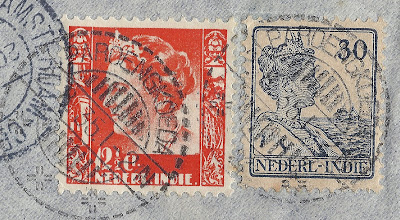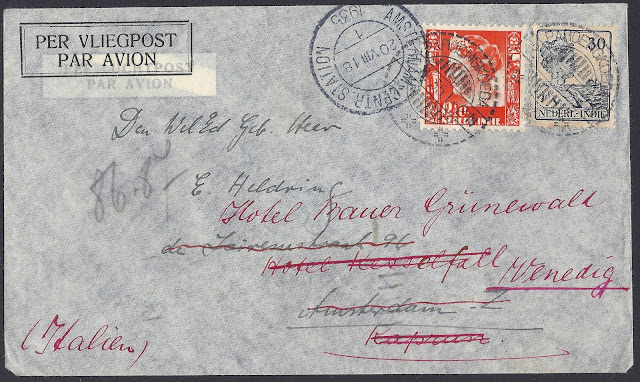 |
| PH-AKR 'Rietvink'. This DC-2 aircraft carried the letter from Bandoeng to Amsterdam Schiphol |
After a while though I wasn't so sure anymore: I looked the flight up in TSchroots' great airmail encyclopedia and read that the DC-2 'Rietvink' departed Bandoeng on the 3rd of August and arrived accordingly to its flight schedule in Amsterdam on the 8th. No engine failure whatsoever, just a lazy philatelist which jumped to conclusions too quickly.
It think we might have been tricked by the Amsterdam postmark. This 'pseudo-arrival' postmark is probably only an indication of the time and day on which the letter was forwarded to Venice (and since you're probably more shrewd as I am, you might have guessed that already).
 |
| 'Forwarding postmark' Amsterdam Central Station? |
 |
| Close-up of the two stamps and postmarks |
Now two questions come to mind:
- What is the reason of the 18-day gap between the send date and forwarding date? Did it took Heldring's family so long to forward the letter to him from their home address in Amsterdam? Or did Mr Biesenbach's letter linger in the Javanese forests for some time before reaching Bandoeng? Or...?
- What were Mr Heldring businesses in Kaprun and Venice? His wife (or assistant) first wrote down the wrong address (Hotel Kesselfall, Kaprun) before correcting it into the more famous Grünewald Hotel in Venice. I think the 'corrector' was perfectly aware of Mr Heldring's travel schedule. He appears to me as an important man. Moreover, his name rung a bell when my eyes met this cover. In fact, in the end I bought the cover because of this name and not because of it's attractive stamping and neat postmarks.
Ernst Heldring - Dutch entrepreneur
Much Dutchmen probably don't remember his name, and if they do they remember his name because of his son. The addressee - Ernst Heldring - nevertheless was a famous and very influential individual during the first half of the last century. Born in 1871, he was educated at the Public School of Trade in Amsterdam during the 1880s. Within 10 years he had established good contacts with the Dutch Indies where he was responsible for numerous (industrial) initiatives, such as the the construction of a harbour in Sabang and a new ship route which connected Java to Japan. He started this last venture in 1902 after having becoming president of the prestigious Royal Dutch Steamboat Company (KNSM) in 1899. Perhaps more important for philatelists is his function as president of the Royal Dutch West India Mail (KWIM) between 1912 and 1928. By that time people called him a proper shipowner ('reder' in Dutch) and in the Netherlands with its long history of trade and ships such a function meant (and still means) influence and prestige. Soon he became known as the Viceroy of Amsterdam. He made it into the upper class of Dutch society.
 |
| Ernst Heldring on the roof of his house (De Lairessestraat 96). Viceroy of Amsterdam. |
In the 1930s Heldring occupied numerous functions, most of them commissionerships, at the Dutch National Bank, the Hoogovens and the Dutch Trade Company. Most notably for our letter tracing process could have been the position he held at the Holland Bank for the Mediterranean in the mid thirties. Which sort of other business could possible distract you from simmering Italian summers....
For the sake of all of us, he had the extraordinary gift to keep his diary up to date. So here are some notes of his own hand, written in September 1935 which will tell you his real activities in the summer of 1935.
~
Gisteravond thuisgekomen van 4 weken vacantie in Beieren, Oostenrijk en Italië met Jet als reisgezelle. We hadden prachtig weer, behalve in de bergen, waar we ons voornemen tochten te maken moesten opgeven, toen we voldoende getraind waren. De laatste 8 à 9 dagen brachten we te Venetië, Padua en Verona, Brescia, Bergamo en Milaan door. Venetië is een oude bekende, die ik gaarne terugzie. Ditmaal was er in het Palazzo Pisaro een prachtige tentoonstelling van werken van Titiaan, waar zijn meesterschap in portretkunst, het coloriet en de compositie, doch ook zijn tekortschieten in geestelijke diepte - geheel overeenkomstig zijn tijd en omgeving - gedemonstreerd werden. Ditmaal bezocht ik ook het oud-Romaansche, half-Byzantijnsche kerkje te Torcello op een afgelegen lagune-eiland. Heel mooi. De Giotto's en Mantegna's te Padua waren een verrukking bij het weerzien na 30 jaren, zoo ook Verona. De musea in beide steden, vooral dat te Padua, vond ik uitmuntend gereorganiseerd. Te Brescia waren we slechts een paar uur tusschen 2 treinen, wegens slagregen grootendeels in een café. Het oude Bergamo op den berg gelegen met zijn door kerken en loggia's omgeven piazza is een juweel.
~
Translation:
Yesterday I returned after having spend 4 weeks of holidays in Bavaria, Austria and Italy with Jet as my travel companion. The weather was great, except in the mountains, where we had to give up our intention of making walks after sufficient training. The last 8/9 days we stayed in Venice, Padua, Verona, Brescia, Bergama and Milan. Venice is like an old acquaintance, whom I very much like to visit again. This time there was a beautiful exposition of pieces of Titian, where his mastery in portrait art, of colorite and composition, but also his under performance in philosophy- which perfectly corresponds to his age and surroundings - was demonstrated. I visited the old and small Romanic, half Byzantine church of Torcello as well this time, which stands on a remote island in the lagoon. Very pretty. To see the paintings of Giotto and Mantegna again in Padua was a sheer delight after 30 years. The same applies to Verona. I found that the museums in both cities were very well organized, especially in Padua. Since we had to switch trains in Brescia, we had only a couple of hours to visit this city. (Unfortunately) We had to take shelter in a cafe because of a downpour. The ancient city of Bergamo situated on its mountain and its piazza surrounded by churches and loggia's is a gem.
So Mr Heldring was not for business in Italy and Austria: he enjoyed a lengthy holiday there! One mystery solved.

















